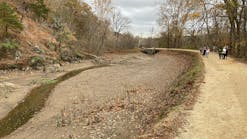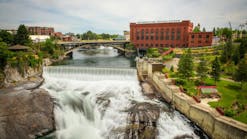Mike McGough & Mark McCord
undefinedWhen development of the East Village retail center began, storm water detention was a major point of debate. This site, just north of Atlanta in Roswell, Ga., sits in a highly developed corridor in need of some redevelopment. Haines, Gipson and Associates, the engineer of record, considered several detention options during the design process.
The original design was a concrete vault, but cost and timing brought other ideas into the arena. Offsite drainage to adjacent ponds, chambered systems and the concrete vault came with a slew of issues, including cost, footprint size, drainage easements, permitting and construction time.
Detention Decisions
During a value engineering session with the general contractor, a corrugated steel pipe (CSP) detention system was proposed. As a result of the volume required for storage, the system quickly grew and expanded outside of the usable area for detention. But due to a considerable elevation change to the outfall, the idea of tiered CSP detention was put on the table. When the smoke cleared and all of the numbers were on the table, the tiered CSP became the most feasible option.
The material cost of the CSP system reduced the initial budget by approximately $200,000. Furthermore, it saved time and labor costs because it was quick and easy to assemble and stayed within the originally designed footprint.
Simply stated by Scott Samuel of Haines, Gipson and Associates: “At the end of the day, the pipe system won out in cost and timing.”
Fabrication, Delivery & Installation
The final detention design for East Village was a tiered 144-in., 10-gauge Aluminized Steel Type 2 CSP detention system.
With timing as a major issue, Southeast Culvert Inc. (SEC), Winder, Ga., went to work. The project required more than 800,000 lb of steel. With the help of AK Steel, SEC was able to procure the balance of the material needed to complete the project. From the arrival of the steel, SEC spent three weeks producing the pipe and fabricating the required fittings for the detention.
Structural reinforcement measures were taken to ensure that the bottom system maintained its integrity. SEC performed finite element analysis of the manifold systems to ensure long-term structural performance under dead and live loadings. Once fabrication was complete, the company took on the sizeable task of delivering 3,500 ft of 144-in. pipe to the job site.
The system arrived on time, and the contractor spent the next two months installing the pipe in conjunction with a massive retaining wall being constructed next to the tiered system. The detention installation was slowed dramatically due to the close proximity of the wall, but total time spent on construction of the system was approximately two weeks.
The detention system is designed with 3 ft of backfill separating the tiers. The top and bottom systems are offset to distribute the loading and to allow access risers to the bottom system. The lower system experiences less loading than a single system at the same depth because the pipes above cause less loading than the typical ±120 lb per cu ft of compacted soil.
The contractor backfilled the systems using a quarry sand in order to achieve acceptable levels of compaction. The pipe joints were wrapped with a geotextile fabric to eliminate any risk of infiltration of the backfill. Due to the contractor’s diligence and careful monitoring by SEC, the installation went smoothly and met all expectations.
A Solid Future
The 144-in.-diameter, 5-in.-by-1-in. corrugation profile, 10-gauge pipe is structurally capable of accepting up to 39 ft of soil cover, assuming sound installation practices. Strides in material understanding and technology over the last few decades have produced more durable products: Studies show that 10-gauge Aluminized Steel Type 2 installed in normal soil pH and resistivity will provide a service life beyond 100 years.
An often overlooked advantage of using CSP is the well documented recycled content in every foot of pipe manufactured—a bonus for projects certified under the U.S. Green Building Council Leadership in Energy and Environmental Design (LEED) program.
Today, construction of East Village is complete and new projects are emerging around it, breathing new life into an area in need of smart development. Thanks to a few progressive-thinking engineers and contractors, the retail center has a functional and durable detention system unlike any other.







